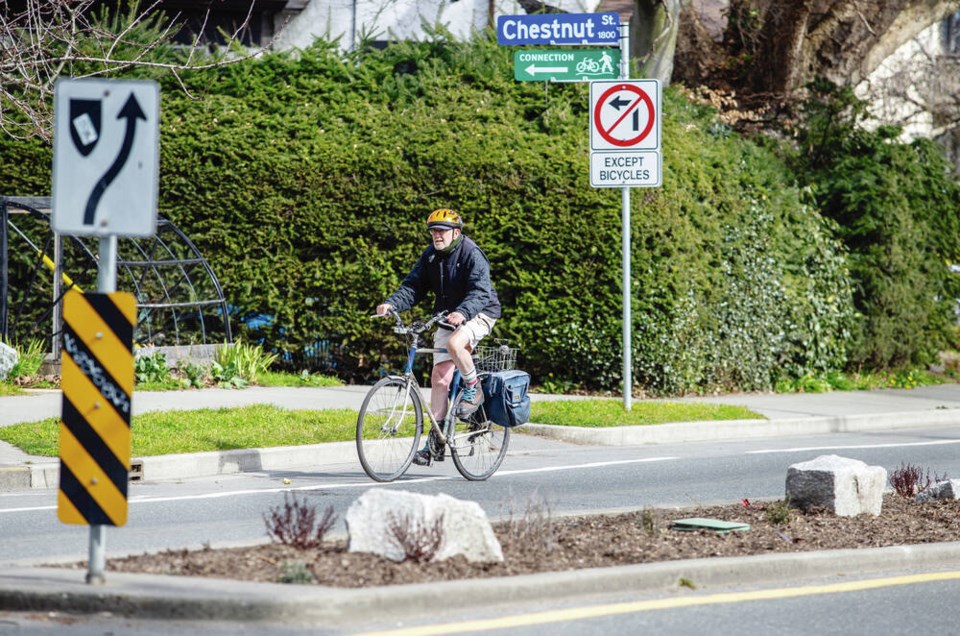In any attempt to level a playing field, in this case that of motorists and cyclists, the issue of fairness is a key consideration.
Some questions for council candidates and voters:
• As they use their preferred mode of transport, are some Victoria motorists being unfairly inconvenienced by the new cycling infrastructure?
• Are some current and potential cyclists in Victoria being unfairly precluded from using their preferred mode of transport due to the missing safety provided by a connected network of bicycle routes?
• Until all remedial traffic calming has been completed, is the temporary disturbance of increased volume on nearby neighbourhood streets worth the permanent benefits of the Richardson bikeway link in an all ages, all abilities (AAA) cycling infrastructure?
To a great extent the answers depend on how much cyclist safety, driver inconvenience and neighbourhood disturbance is required to reap the benefits of increased cycling through safe infrastructure. The benefits include reduced noise and harmful air pollutants, improved physical fitness and mental health, saved money on gas and car expenses, greater equity for Victorians who don’t have a car and reduced risk of injury to cyclists. For motorists, every potential driver on a bike means one less car filling the roadway and competitor for parking spots.
The requisite cycling safety is the 32 kilometres of AAA continuous and connected street cycling infrastructure the City of Victoria has committed to completing by 2023.
It consists of a network including physically separated bike lanes (such as Wharf and Fort), shared neighbourhood bikeways (such as Richardson and Vancouver) and off-street pathways such as the Dallas Road multi-use trail. Esquimalt and Saanich are installing some similar infrastructure. Once its network is complete, 95 per cent of the City of Victoria will be within 500m of a AAA cycling route.
As for driver inconvenience, there is the loss of traffic lanes, such as on Fort, and some through-traffic routes such as Richardson and Vancouver. Some trips on the alternative routes, such as Cook Street, Quadra Street, Oak Bay Avenue or Fairfield Road can take longer depending on the day and time.
Given the months it can take for motorists to adjust to such changes, the disturbance of increased traffic on some nearby streets is now around the Richardson bikeway.
In response, city staff are both implementing and planning additional traffic calming measures to ensure non-local motorists use Oak Bay Avenue or Fairfield Road.
The big unknown: If you build it, will they come? Simon Fraser University’s six-year study of bicycle infrastructure in Victoria, Kelowna and Halifax (www.sfu.ca/ibims.html) suggests they will; and that there are tens of thousands of potential converts to cycling, and more cycling, living in the four core municipalities of Victoria, Esquimalt, Oak Bay and Saanich if given appropriate infrastructure.
Of the over 200,000 people 18 or older in this area, 70 per cent have one or more adult bikes in their household, 11 per cent have an e-bike and more than 50 per cent want to travel by bicycle more than they do now.
Unfortunately, 80 per cent don’t feel comfortable on a busy major street without some form of cycling infrastructure. In 2021 only 53 per cent had used a bike in the past year, while one-third said they are interested in cycling … but concerned.
Given this demand, it’s not surprising that 74 per cent think building more bicycle infrastructure is a very or somewhat good idea. If built, 65 per cent of cyclists said they would cycle more and 35 per cent of non-cyclists said they would be more likely to cycle. Only 20 per cent said “no way no how” to cycling.
As conversion happens one person at a time, where current and would be cyclists do what they say they would in the SFU study if provided safe infrastructure, it will take a great many more months to determine a final number on mode share shift. Indeed, years, as the number will include a good percentage of the 20 per cent increase in population in the region over the next 20 years.
The interim measurements of the degree to which the new AAA infrastructure has shifted mode share in the City of Victoria are encouraging. For example, ridership on the Richardson bikeway increased from a daily average of 389 bikes in the fall of 2019 to 701 in September 2022. Prior to the infrastructure installation on Wharf Street, ridership was stagnant at about 600 per day but now averages 1,600 trips per day.
So, has the playing field been levelled fairly? We won’t know for sure for quite a while.



